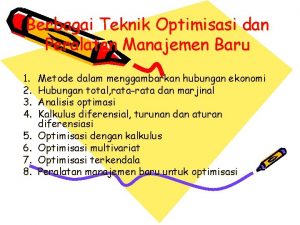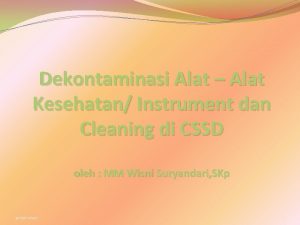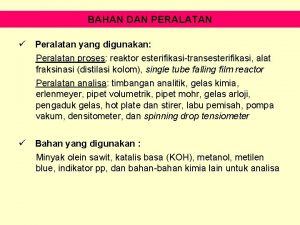Pengantar Teknik Kimia Sesi 1 Peralatan Proses Ir

















- Slides: 17

Pengantar Teknik Kimia Sesi 1: Peralatan Proses Ir. Abdul Wahid Surhim, MT.

ROTARY PUMP Disusun oleh : Kevin Naldo 0606076545 Linda Tjahjadi 0606076551 Linna 0606076564 M. Aditya Putra 0606076570

FAMILY TREE OF PUMP

ROTARY PUMP Rotary pumps are used in a wide range of applications -- liquids, slurries, and pastes. And because rotary pumps displace a known quantity of liquid with each revolution of the pump shaft, they are a popular choice for metering applications. They can accommodate high viscosity liquids, high pressures, and high capacities. l Rotary pumps are available in a number of different pumping principles, each with its own unique set of advantages and disadvantages. l

ROTARYPUMPCLASIFICATION l Rotary Pump devided into 2 Chapter: 1. single rotor -vane -piston -screw -peristaltik -progressing cavity 2. multiple rotor -gear -lobe -screw -circumferential piston

VANE PUMP l The vanes - blades, buckets, rollers, or slippers - work with a cam to draw fluid into and force it out of the pump chamber. The vanes may be in either the rotor or stator. The vane-in rotor pumps may be made with constant or variable displacement pumping elements. Figure 4 shows a sliding vane pump.

Vane Pump pics

SCREW PUMP Screw pumps carry fluid in the spaces between the screw threads. The fluid is displaced axially as the screws mesh. l Single screw pumps are commonly called progressive cavity pumps. They have a rotor with external threads and a stator with internal threads. The rotor threads are eccentric to the axis of rotation. l Multiple screw pumps have multiple external screw threads. These pumps may be timed or untimed. l

Screw pump pics Single screw pump Three screw pump

GEAR PUMP Internal Gear. Internal gear pumps carry fluid between the gear teeth from the inlet to outlet ports. The outer gear (rotor) drives the inner or idler gear on a stationary pin. The gears create voids as they come out of mesh and liquid flows into the cavities. As the gears come back into mesh, the volume is reduced and the liquid is forced out of the discharge port. The crescent prevents liquid from flowing backwards from the outlet to the inlet port. l External Gear. External gear pumps also use gears which come in and out of mesh. As the teeth come out of mesh, liquid flows into the pump and is carried between the teeth and the casing to the discharge side of the pump. The teeth come back into mesh and the liquid is forced out the discharge port. External gear pumps rotate two identical gears against each other. Both gears are on a shaft with bearings on either side of the gears. l

Gear pump pics Internal gear Eksternal gear

GEAR PUMP l Gear pump is the most commonly use in daily life. This pump doesn’t have valve and the seal depend on the small distance between gear wheels and the case. This pump flow fluid in the high pressure until 35 MN/m 2.

LOBE l Fluid is carried between the rotor teeth and the pumping chamber. The rotor surfaces create continuous sealing. Both gears are driven and are synchronized by timing gears. Rotors include bi-wing, tri-lobe, and multi-lobe configurations.

Lobe pump pics Lobe Pump

CIRCUMFERENTIAL PISTON l Fluid is carried from inlet to outlet in spaces between piston surfaces. Rotors must be timed by separate means, and each rotor may have one or more piston elements.

Circumferential piston pump Circumferential Piston Pump

Liquid containment l l l l High-Viscosity Liquids. Internal gear pumps are often a good choice. Sanitary Liquids. Sanitary lobe pumps work well for most food, beverage, pharmaceutical, and biotechnology applications. Solids. Pump selection depends on the particular application. For food-type applications containing solids, begin searching sanitary lobe pumps. For slurries and other industrialtype solids, start with internal gear pumps. Corrosive Liquids. Proper selection of the right materials of construction will have the greatest impact on pump performance. Composite external gear and stainless steel internal gear pumps are good starting points. Check out Pump School's page on handling abrasive and corrosive liquids. Abrasive Liquids. A number of factors can combine to minimize the effects of abrasion. Begin with internal gear pumps manufactured with hardened steel parts. Toxic, Hazardous, or Hard-To-Seal Liquids. Preventing leaks is critical for handling these fluids. Magnetically-driven or mechanically sealed internal or external gear pumps offer a good starting point. Extreme Temperature Conditions. Internal gear pumps with jacketing features offer excellent temperature control. Learn more about handling high-temperature liquids in Pump School's "Tough Application" section.
 Sistem konvensional
Sistem konvensional Contoh optimisasi terkendala
Contoh optimisasi terkendala Berbagai teknik optimasi dan peralatan manajemen baru
Berbagai teknik optimasi dan peralatan manajemen baru Bulk deformation processes
Bulk deformation processes Soal uas pengantar teknik kompilasi gunadarma
Soal uas pengantar teknik kompilasi gunadarma Pengantar gambar teknik
Pengantar gambar teknik Lulusan ti mana tim berners teh
Lulusan ti mana tim berners teh Pengantar teknik kompilasi
Pengantar teknik kompilasi Pengantar teknik mesin
Pengantar teknik mesin Proses peralatan bekas pakai menurut dr earl spaulding
Proses peralatan bekas pakai menurut dr earl spaulding Klasifikasi spaulding
Klasifikasi spaulding Harga pokok proses lanjutan adalah
Harga pokok proses lanjutan adalah Metalik barsak sesi
Metalik barsak sesi Solunum paternleri
Solunum paternleri Sonar cihazının sesi duyulur mu
Sonar cihazının sesi duyulur mu Normal barsak sesi dakikada
Normal barsak sesi dakikada K,ek,ke,eke,ak,ka,aka
K,ek,ke,eke,ak,ka,aka Elakin ses grupları
Elakin ses grupları

































